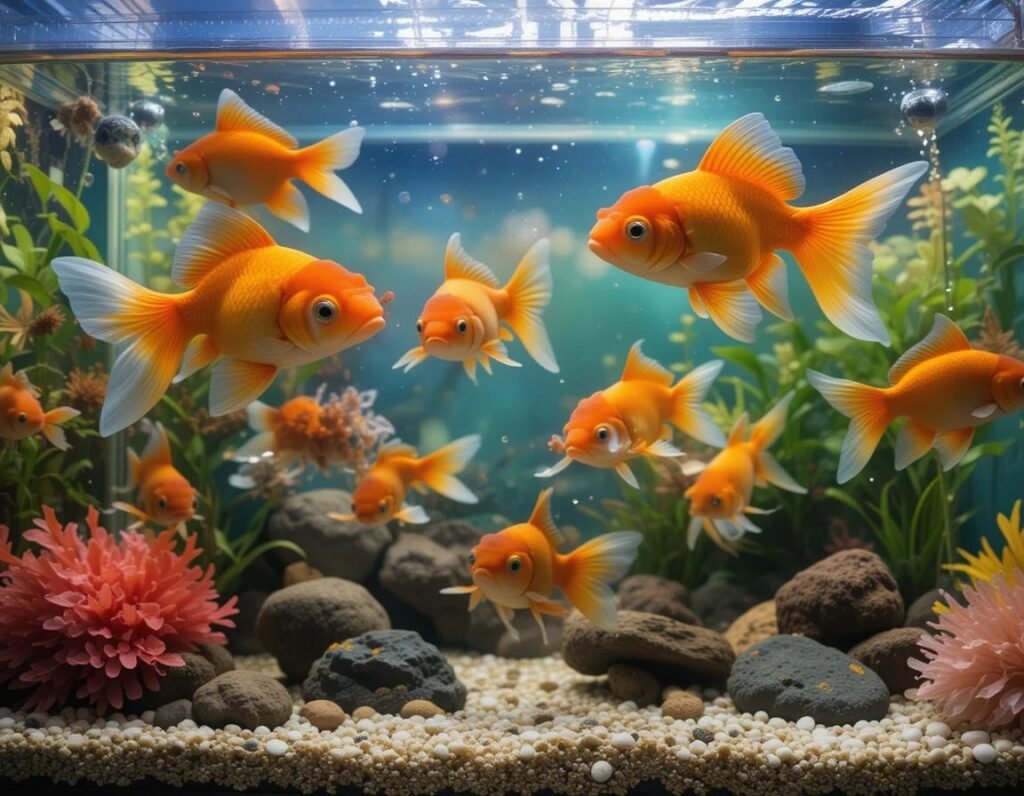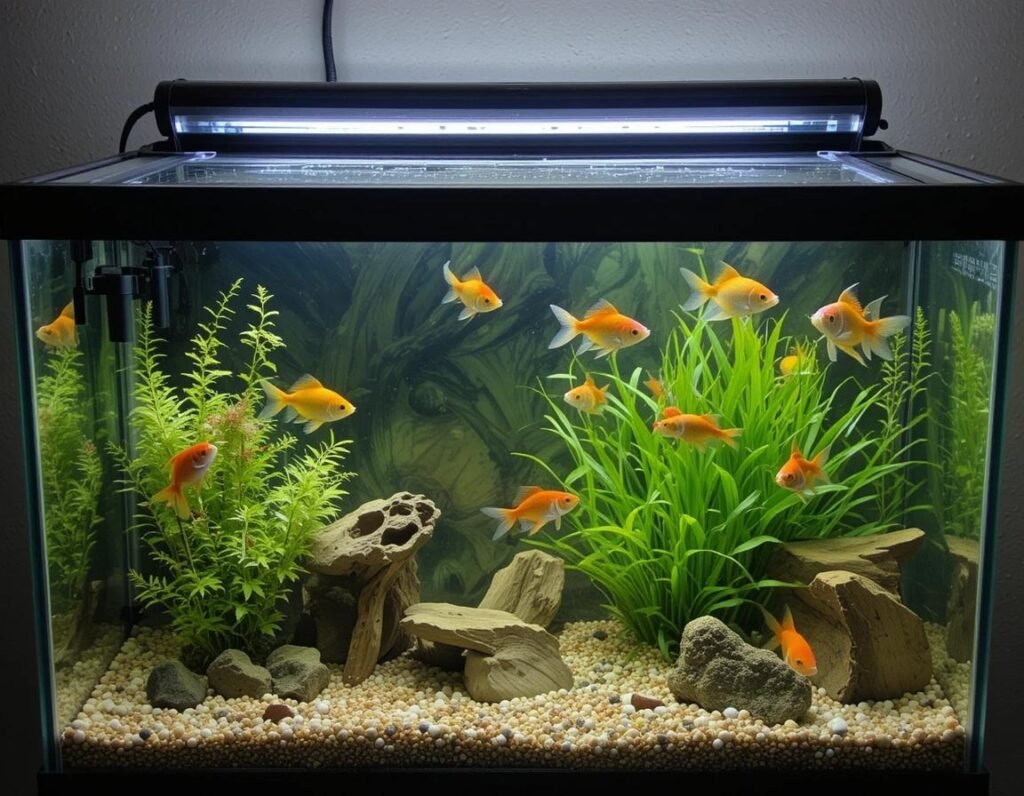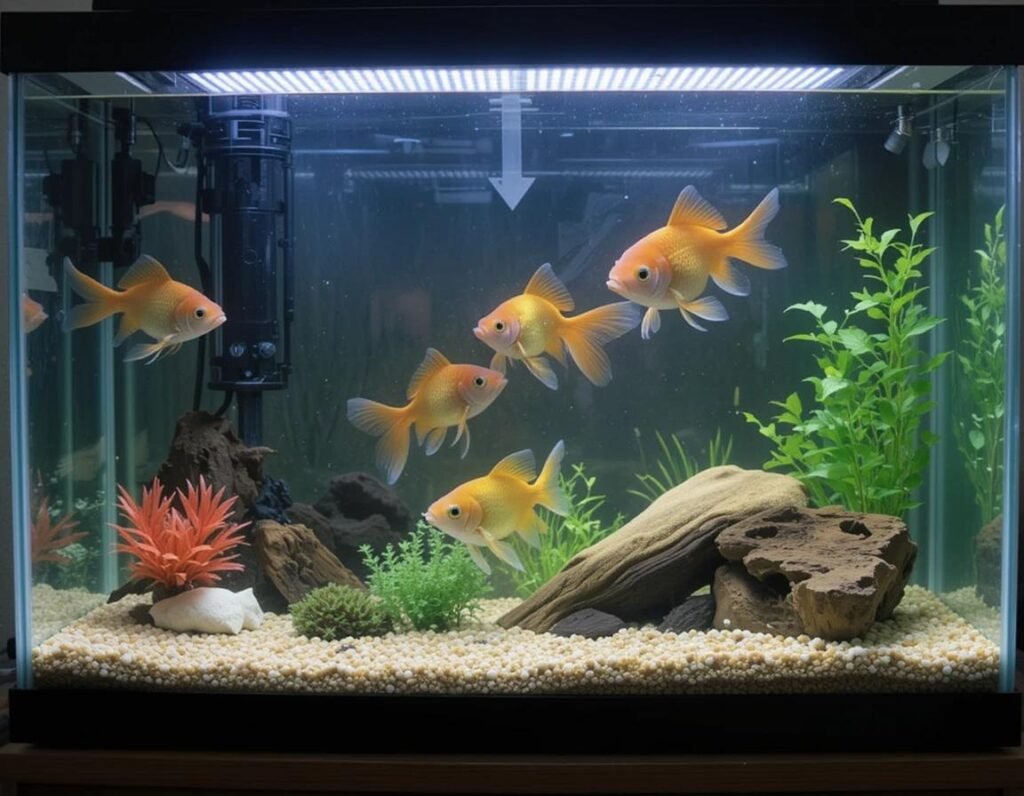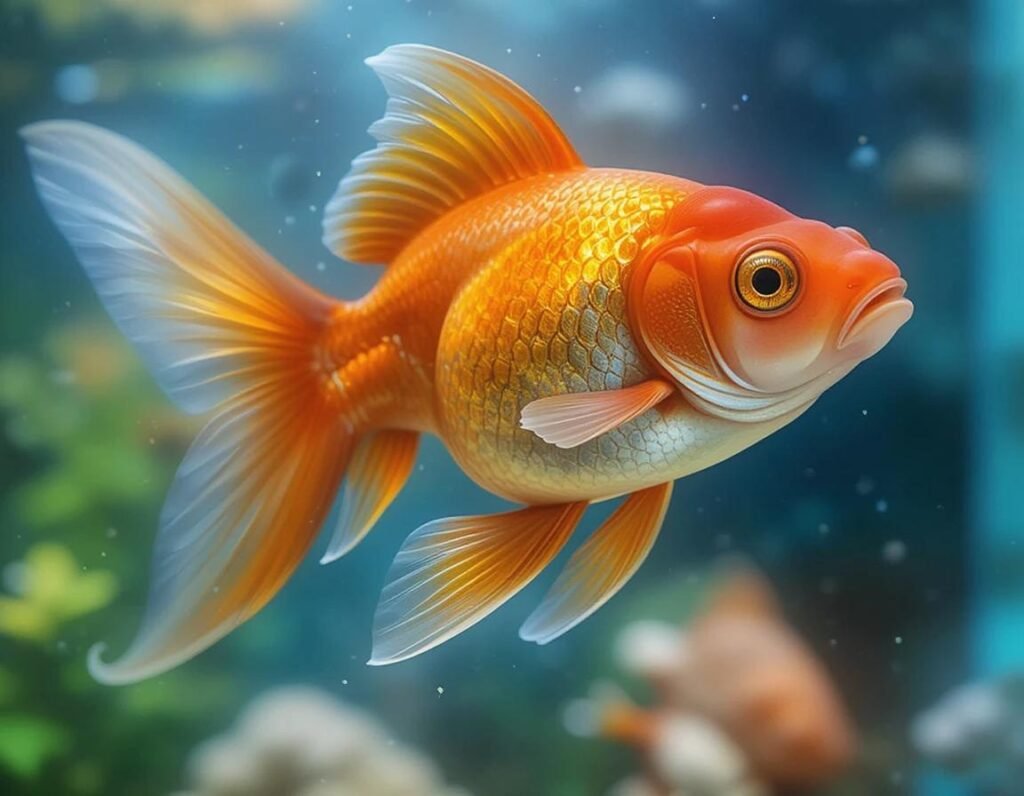
How to set up a goldfish aquarium for beginners
Setting up a goldfish tank might sound like a simple task, but it’s actually an art. It’s a little like setting up a cozy fishy apartment, complete with the best furnishings, water features, and lighting. Goldfish need more than just a bowl to swim around in—they need the right environment to stay happy, healthy, and vibrant. And guess what? You get to be their interior designer!
In this article, we’ll walk you through how to set up the perfect goldfish tank, including some common mistakes to avoid, all while making sure your finned friends live their best lives. Ready? Let’s dive in!
Step 1: Choose the Right Tank Size
Here’s the deal—goldfish are not meant for small bowls. Sure, they look cute in those tiny, round glass bowls, but trust us, they’ll be way happier in a spacious tank. Goldfish can grow up to 12 inches in length, and they need plenty of room to swim and stretch out their fins.
Tank size tips:
- For 1 goldfish, go with at least a 20-gallon tank.
- For 2 goldfish, aim for a 30-gallon tank.
- For each additional goldfish, add 10-15 gallons of space.
Why so much space? Well, goldfish produce a lot of waste, and a larger tank gives you a better chance at keeping the water quality high. Plus, they’ll have more room to swim, explore, and live their best fishy life. After all, no one wants to live in a cramped space, not even a goldfish!
Step 2: Get the Right Filtration System
Goldfish are like little swimming snack machines—they eat, they digest, and, well, they poop (a lot). A good filtration system is essential to keep the water clean and healthy for your fish. Without proper filtration, the water quality will drop fast, and your goldfish won’t be so happy. In fact, they’ll probably look at you with judgmental eyes, as if to say, “Really? You let the tank get this dirty?”
Choosing a filter:
- Go for a canister filter or a power filter. These are great options for goldfish tanks because they provide strong filtration and help maintain the water’s quality.
- Ensure the filter is rated for a larger tank, at least twice the tank’s volume per hour.
And don’t forget to clean the filter regularly! The whole point is to keep your tank’s water fresh—your goldfish will thank you for it by being extra shiny and active.
Step 3: Add the Right Substrate (Gravel or Sand)
Now, let’s talk about the bottom of the tank—literally. You’ll need to choose the right substrate for your goldfish. This is the material that covers the bottom of the tank, where your goldfish will spend a lot of time. Some goldfish like to sift through gravel, while others enjoy exploring the softer texture of sand.
Gravel vs. Sand:
- Gravel is a good option for goldfish. Just make sure the gravel pieces are not too small (so your goldfish don’t accidentally swallow them) and that they’re smooth, without sharp edges.
- Sand can be a bit tricky since it can get sucked into the filter. But, if you go for a coarse-grain sand, it’s a good option for creating a natural look and feel.
Pro tip: Make sure your goldfish tank’s substrate is easy to clean. You don’t want to get stuck with a dirty bottom and a cranky fish!
Step 4: Set Up Proper Tank Decor and Plants
Goldfish may not need fancy décor, but they sure love a good hideout or something to swim around. Plus, adding a few aquatic plants can provide hiding spots, help keep the water clean, and give your tank a natural, vibrant look.
Goldfish-friendly decor ideas:
- Live plants: Goldfish love nibbling on plants, so make sure they’re hardy, like Java fern, Anubias, or Hornwort. These plants can tolerate a bit of goldfish nibbling and still look good.
- Smooth rocks: Smooth, rounded rocks can add a touch of nature, but avoid anything sharp that could harm your goldfish.
- Plastic decorations: Be careful with these—if they have sharp edges, they can injure your goldfish. Stick with smooth plastic decorations, or better yet, opt for natural items like driftwood or flat stones.
Remember, while your goldfish may enjoy the occasional plant salad, don’t go overboard with decorations—there’s a fine line between “natural” and “cluttered.”
Step 5: Maintain Proper Water Parameters
Now, this is the part where your fish-parent skills will shine! Maintaining proper water parameters is key to keeping your goldfish healthy. Goldfish are quite sensitive to water quality, and any sudden changes can cause stress or illness.
Key water parameters to monitor:
- pH levels: Goldfish prefer a pH between 7.0 and 7.4.
- Water temperature: Goldfish like cooler water, around 65°F to 75°F (18°C to 24°C).
- Ammonia, nitrites, and nitrates: These should be as close to 0 as possible, with nitrates below 40 ppm.
Make sure to test the water regularly with an aquarium test kit. You’ll want to keep things stable, because no one likes living in a constantly changing environment—not even goldfish!
Step 6: Add Lighting and Heating (Optional)
Goldfish don’t need much in terms of lighting, but they do appreciate a nice, gentle light to mimic a natural day-night cycle. A low-wattage aquarium light will work fine. This helps your plants thrive, and it also lets your goldfish show off their natural colors.
As for heating, goldfish are cold-water fish, so they don’t need a heater unless you live in a place with extremely cold temperatures. If you do need a heater, go for one with adjustable settings so you can keep the water temperature within the ideal range.

Final Thoughts: A Happy Goldfish = A Happy Owner
Setting up a goldfish tank is all about creating a healthy, comfortable environment for your little finned friend. Once you get the basics right—tank size, filtration, substrate, and water parameters—you’ll have a goldfish that’s happy, active, and looking fabulous.
And let’s be honest, there’s something extra satisfying about watching your goldfish swim around in their perfectly set-up tank. It’s like they’re living in a luxury fish resort, and you’re the gracious host. So, get ready to give your goldfish the VIP treatment they deserve!
Common Mistakes to Avoid When Setting Up a Goldfish Tank
While setting up your goldfish’s dream home is exciting, it’s easy to make some mistakes. Let’s go over a few things you want to avoid to ensure your goldfish don’t end up being grumpy or stressed out (trust me, no one likes a grumpy fish).
1. Overcrowding the Tank
It’s tempting to add a lot of goldfish into your tank because, well, they’re so adorable, right? But overcrowding can quickly lead to poor water quality and stressed-out fish. Always make sure you stick to the rule of thumb for tank size—1 goldfish per 20 gallons—and don’t add new fish until your tank is properly cycled and established.
2. Forgetting About Water Changes
Goldfish are messy creatures. They’re cute and all, but they have a lot of waste to deal with! That’s why regular water changes are a must. Change out 25% of the water every 1-2 weeks to keep the water clean and free of harmful chemicals like ammonia and nitrites.
If you skip water changes, your tank can quickly become a fishy swamp, and no one wants that.
3. Ignoring Proper Filtration
Sure, you’ve got a filter, but is it the right kind? A small, underpowered filter won’t do the job. You need a filter that’s rated for the size of your tank and can handle the extra load that goldfish produce. When it comes to filtration, it’s better to have more than enough than too little!
4. Skimping on Tank Size
Remember that goldfish are not small fish, and they grow! Putting them in a tiny tank may look cute, but it’s actually cruel in the long run. A cramped space will stunt their growth and make them stressed, so be sure to go big—after all, you want them to live their best goldfish life!
5. Not Cycling the Tank Properly
Before adding your goldfish, make sure to cycle your tank. This means running the tank with just the filter for a few weeks so that beneficial bacteria can build up and help process the waste. If you skip this step, your goldfish might suffer from toxic ammonia spikes, which can be fatal.
Pro tip: If you’re setting up a tank for the first time, consider getting a fishless cycle started by adding ammonia or special cycling bacteria to the water to speed up the process. It takes time, but it’s worth it.
Goldfish Tank Setup: The Bottom Line
In summary, setting up a goldfish tank isn’t just about picking out cute decorations and a stylish filter. It’s about creating a balanced ecosystem where your goldfish can thrive. From choosing the right tank size to keeping the water clean, every decision you make will impact your goldfish’s happiness and health.
And hey, while the setup process might seem a little overwhelming, just remember: goldfish are pretty low-maintenance once their home is set up. Plus, there’s something incredibly satisfying about watching them swim around, happily exploring their space, knowing that you’ve created a perfect little world for them.
So, go ahead, set up that goldfish tank, and get ready to become the proud owner of a fish who might just be living the best life ever. After all, goldfish are known for their short memories, so they won’t even remember how long it took you to get the setup just right. But trust me, you’ll remember the joy of seeing your goldfish swim freely in their new home!
FAQs About Goldfish Tank Setup
1. What size tank is best for goldfish?
Answer: Goldfish need plenty of space to swim, so the general rule is at least 20 gallons for the first goldfish and 10-15 gallons for each additional fish. While they might look adorable in small bowls, your goldfish will be happier and healthier in a larger tank where they can move freely and grow to their full potential.
2. Do I need a filter for my goldfish tank?
Answer: Yes, absolutely! Goldfish are messy little creatures and produce a lot of waste. A good filter is crucial to maintaining clean water and avoiding toxic buildup, like ammonia. You’ll want a filter rated for a tank larger than the one you have—better to have too much filtration than not enough!
3. How often should I change the water in my goldfish tank?
Answer: It’s essential to change 25% of the water every 1-2 weeks. Goldfish are messy eaters, and regular water changes help keep the water quality high, preventing harmful toxins from building up. If you have more goldfish or a smaller tank, you may need to change the water more frequently.
4. Can I use tap water for my goldfish tank?
Answer: Yes, but you should treat tap water before adding it to the tank. Tap water often contains chlorine, which can harm your fish. Use a water conditioner to neutralise the chlorine and other chemicals, making the water safe for your goldfish.
5. Do goldfish need live plants in their tank?
Answer: While goldfish don’t need live plants, they definitely benefit from them. Live plants help oxygenate the water, absorb excess nutrients, and provide hiding spots. Just make sure to choose plants that are goldfish-friendly, like Java fern or Anubias, as goldfish love to nibble on plants.

6. How do I set up the substrate in my goldfish tank?
Answer: For goldfish, you’ll want a smooth gravel or coarse sand substrate. Avoid sharp-edged gravel, which could hurt their delicate fins. Goldfish love to forage through the substrate, and the right substrate helps to establish beneficial bacteria and maintain water quality.
7. What temperature should my goldfish tank be?
Answer:Goldfish prefer cooler water, typically around 65°F to 75°F (18°C – 24°C). They are cold-water fish, so avoid placing the tank in direct sunlight or a warm room. If you live in a particularly hot climate, you might need a cooling fan or air conditioning to regulate the temperature.
8. Should I add decorations to my goldfish tank?
Answer: Yes, but make sure the decorations are smooth and safe for your goldfish. They might swim through caves, hide behind rocks, or explore plants. Avoid anything with sharp edges that could tear their fins or cause injury. Natural items like driftwood or smooth stones are great options.
9. Can goldfish live in a community tank with other fish?
Answer: Goldfish are generally peaceful, but they do best with other similar-sized fish. Avoid small fish that might get eaten or aggressive fish that could bully your goldfish. Good goldfish tank mates include other goldfish and peaceful, cold-water fish like white cloud minnows or weather loaches.
10. How long does it take to set up a goldfish tank?
Answer: Setting up a tank can take anywhere from a few hours to a day, depending on how prepared you are. Make sure to let the tank cycle for 2-3 weeks before adding fish. This ensures that the biological filtration system is ready to handle the waste your goldfish will produce.
11. Can I use a heater in a goldfish tank?
Answer:Goldfish don’t need a heater, as they are cold-water fish. However, if you live in a region where temperatures drop below 60°F (15°C), you might need a low-wattage heater to maintain a comfortable water temperature. Just make sure the heater doesn’t make the water too warm for your fish.
12. Can I keep more than one goldfish in a tank?
Answer: Absolutely! Goldfish are social animals and enjoy the company of their own kind. Just be mindful of the tank size and how many fish you have. A good rule of thumb is 20 gallons for the first goldfish and 10-15 gallons for each additional fish. Overcrowding can cause stress and poor water quality, so make sure you have enough space.
13. Do I need to cycle the tank before adding goldfish?
Answer: Yes, cycling is crucial! Before adding your goldfish, you should run the tank with just the filter for a few weeks to allow beneficial bacteria to grow. This helps process waste and keeps the water safe for your fish. It might sound like a lot of work, but it’s worth it for your goldfish’s health.
14. Can I use a goldfish bowl instead of a tank?
Answer: While goldfish bowls may look cute, they aren’t ideal for long-term care. They provide very little space, leading to poor water quality and stressed fish. Stick with a properly sized tank to ensure your goldfish has room to grow and live a healthy life.
15. How do I maintain the health of my goldfish tank?
Answer: Routine maintenance is key! Keep an eye on water quality, clean the filter regularly, change the water often, and remove any uneaten food. Also, monitor the health of your goldfish for signs of illness like faded color or lethargy, and make sure your tank has no sharp objects that could harm your fish.


